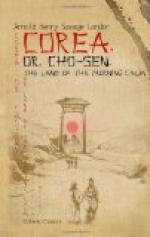Following the path, then, which leads from the West to the South Gate, and which winds its way up steep hills, one comes at last to the temples. These are probably, the best-preserved and most interesting in the neighbourhood of the Corean capital. When I visited them, the monks were extremely polite and showed me everything that was of any note. The temples were in a much better state of preservation than is usual in the land of Cho-sen, and the ornaments, and paintings on the wooden part under the roof were in bright colours, as if they had been only recently restored. There are, near these temples, by the way, tablets put up in memory of different personages. In other respects, they were exactly similar to those I have already described in a previous chapter.
At last, on the left hand side, I came upon the old palace. As with all the other palaces, so in this case there are many low buildings for the inferior officials besides a larger one in the centre, to which the King can retreat in time of war when the capital is in danger. The ravages of time, however, have been hard at work, and this place of safety for the crowned heads of Corea is now nothing but a mass of ruins. The roofs of the smaller houses have in most cases fallen through, owing to the decayed condition of the wooden rafters, and the main building itself is in a dreadful state of dilapidation. The ensemble, nevertheless, as one stands a little way off and looks at the conglomeration of dwellings, is very picturesque; this effect being chiefly due, I have little doubt, to the tumble-down and dirty aspect of the place. As the houses are built on hilly ground, roof after roof can be seen with the palace standing above them all in the distance, while the battlements of the ancient wall form a nice background to the picture.
[Illustration: A MONK]
The most picturesque spot of all, however, is somewhat farther on, where the rivulet, coming out of the fortress wall, forms a pretty waterfall. After climbing a very steep hill, the South Gate is reached—the distance between it and the West Gate being about five miles—and near it is another smaller gate, which differs in shape from all the other gates in Corea, for the simple reason that it is not roofed over. Just outside the small South Gate, on the edge of a precipice, are constructed against the rocks a pretty little monastery and a temple. The access to these is by a narrow path, hardly wide enough for one person to walk on without danger of finding himself rolling down the slope of the rock at the slightest slip of the foot. The Buddhist priest must undoubtedly be of a cautious as well as romantic nature, for otherwise it would be difficult to explain the fact that he always builds his monasteries in picturesque and impregnable spots, which ensure him delightful scenery and pure fresh air in time of peace, combined with utter safety in time of war. In many ways, the monastery in question reminded me of the Rock-dwellers. Both temple and monastery were stuck, as it were, in the rocks, and supported by a platform and solid wall of masonry built on the steep incline—a work which must have cost much patience and time.




